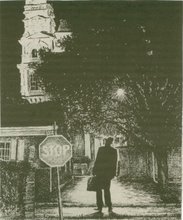
 (photographs by Ernie Morin)
(photographs by Ernie Morin) Italians have two principal verbs for walking. “Camminare” means simply getting about on foot, while “passeggiare” has the more formal connotation of taking a stroll. As a noun “passeggiata” also means promenade, as of an evening’s stroll along the boulevard or in the populous square of a Sicilian town. Since the advent of the automobile, “passeggiare” can also mean going for a drive.
I’m reminded of these words at St. Peter’s Fiesta as I watch the strolling crowds of children and their parents--brightly dressed teens, kids on scooters, even skateboarders--converging on the square that has been home for 80 years to Gloucester’s most profound celebration of our collective identity (this year's Fiesta began on Thursday, June 28 and ended on Sunday, July 1, 2007).
La Festa di San Pietro is many things. It pays homage to the patron saint of Gloucester’s Italian fleet and it’s also a Solstice celebration. As winter and spring give way to summer, fishermen and their families thank St. Peter for what the sea provides. Competitions like the dory races and the greasy pole contest have their origins in ancient games of strength, whose deeper roots lie in Greek, Sicilian and Near Eastern fertility rites. The climax of the celebration is the blessing of the fleet; and its denouement is the late night procession during which the statue of St. Peter is carried by fishermen and their family members through the streets of the Fort and returned to its resting place in St. Peter’s Club.
One doesn’t have to travel to Italy to understand this powerful annual event. Much of Italy has been transported to Gloucester and remains here in the traditions of our Sicilian community through folkways like St. Joseph’s Feast and the yearly novenas of the Mothers of Grace Club on Washington Street. For that reason, living in Italy often seemed to me like being home in Gloucester. A great deal of what I experienced during the years I spent as a graduate student and teacher in Florence, or on my travels throughout the country that remains my spiritual home—-men drinking coffee and talking politics in cafes, widows dressed perennially in black, children kicking a soccer ball in the street--was familiar to me from growing up here.
That is why I love the idea of Fiesta. As long as there is an Italian community to celebrate it and fishermen to be honored, Gloucester is still Gloucester as we know it.
Fiesta is rite and ritual, it is games of strength and skill. It’s a giant block party and mating dance as young people from all over the city meet and mingle. But Fiesta is also Gloucester’s great annual passeggiata. It’s the place where everyone strolls through the Fort, among the carnival booths, the rides, the games of chance. There is food in abundance-the sizzling Italian sausages and hot peppers, fried dough, cotton candy, candied apples. Fiesta is where old friends and relatives meet, where kids home from college or the service, from jobs in other towns, reunite. It’s where the winter’s babies are proudly displayed and where newly married couples, or those about to be married, declare their love.
Passseggiata in Italy has, from Roman times, been a traditional public ritual. During the evening stroll eligible sons and daughters gave each other the eye under the attentive gaze of parents. The poor observed the habits of the rich, while the rich prided themselves on their ability to set examples of decorum. Confined mostly now to small towns (although the custom still prevails in Naples and Palermo, and Romans have long had to share Via Condotti, Villa Borghese and the Piazza di Spagna with tourists), passeggiata has largely given way to those drives in the car that its secondary meaning describes, or simply to the new life of bar hopping, movies and night clubs that has become the international pastime of young people no longer restrained by parental authority.
Yet in Gloucester passeggiata continues as an integral part of St. Peter’s Fiesta. It remains as I remember it from childhood, when our mothers accompanied us to the Fort. One of the passages into adolescence was to be allowed to attend Fiesta alone or with friends. In high school one strolled among the carnival booths with one’s steady date. Indeed, it was de rigueur to show the world that one had a girlfriend or boyfriend.
Fiesta has changed over the years. Some natives lament the midway atmosphere, which appears now to overshadow the religious dimension of the celebration. But part of every spiritual ritual, like Mardi gras, involves both worship and release. What’s important is that after 80 years we still have Fiesta and that it draws the community to our one big public square. Here, under the watchful eyes of St. Peter, we recommit ourselves to the sacredness of Gloucester’s central occupation, that of fishing and the maritime life.

 (photographs by Ernie Morin)
(photographs by Ernie Morin) 

No comments:
Post a Comment